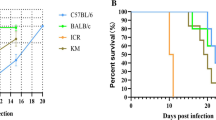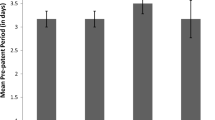Summary
After splenic autotransplantation both weight and blood flow of the regenerated splenic tissue are decreased. In addition, the protective function of the transplant is less compared to that of the normal spleen. In the present study, the red pulp of normal and transplanted splenic tissue was stimulated by injections of phenylhydrazine to increase the weight, the blood flow, and the protective function. After stimulation, the weight of the normal spleen increased to 900 ± 70 mg (control 530 ± 20 mg) and the transplanted tissue to 240 ± 70 mg (control 70 ± 20 mg). This enlargement was caused by an increase in the splenic red pulp. However, the relative blood flow decreased in both the normal spleen and the transplant to 50% of the normal value. To evaluate the protective function of the stimulated splenic tissue, normal, splenectomized and transplanted rats were infected withPlasmodium berghei. Despite the dramatic increase in the red pulp, neither the normal nor the transplanted animals showed a survival rate superior to that of the splenectomized animals. The mass of splenic tissue obviously does not correlate with the protective effect of the spleen in parasitic infections.
Similar content being viewed by others
References
Brown KN, Hills LA (1981) Erythrocyte destruction and protective immunity to malaria: Enhancement of the immune response by phenylhydrazine treatment. Tropenmed Parasitol 32:67–72
Carter R, Diggs CL (1977) Plasmodia in rodents. In: Kreier J (ed) Parasitic Protozoa, vol 3. Academic Press, New York, pp 359–465
Chen LT (1980) Intrasplenic microcirculation in rats with acute hemolytic anemia. Blood 56:737–740
Chen LT, Scheffel U (1977) Blood flow and phagocytic activity of the spleen of the rat with acute hemolytic anemia. J Reticuloendothel Soc 22:507–521
Hara H, Ogawa M (1976) Erythropoietic prescursors in mice with phenylhydrazineinduced anemia. Am J Hematol 1:433–458
Horton J. Ogden ME, Williams S, Coln D (1982) The importance of splenic blood flow in clearing pneumococcal organisms. Ann Surg 195, 172–176
Mendell PL, Hellenberg NK (1971) Cardiac output distribution in the rat: Comparison of rubidium and microsphere methods. Am J Physiol 221:1617–1620
Pabst R, Hafke R, Hillebrand J (1985a) Enhanced regeneration of transplanted splenic tissue by increased workload to the splenic compartments. J Trauma 25:326–328
Pabst R, Hafke R, Hillebrand J (1985b) Enhanced regeneration of transplanted splenic tissue by increased workload. Adv Exp Med Biol 186:565–569
Pabst R, Kamran D (1986) Autotransplantation of splenic tissue. J Pediatr Surg 21:120–124
Pabst R, Westermann J, Hillebrand J, Hafke R (1988) Protective effect of stimulated splenic transplants against rodent malaria. Ped Surg Int (in press)
Sapirstein LA (1958) Regional blood flow by fractional distribution of indicators. Am J Physiol 193:161–168
Sherman R (1981) Rationale for and methods of splenic preservation following trauma. Surg Clin N Am 61:127–134
Singer I (1954a) The effect of splenectomy or phenylhydrazine on infections withPlasmodium berghei in the white mouse. J Infect Dis 94:159–163
Singer I (1954b) The effect of cortisone on infections withPlasmodium berghei in the white mouse. J Infect Dis 94:164–172
Singer I (1955) The influence of age on the intensity of infection withPlasmodium berghei in the rat. J Infect Dis 97:15–21
Smith TF, Johnston RB (1979) Functions of the spleen in host defence against infection. Am J Pediatr Hematol Oncol 1:355–362
Tavassoli M, Ratzan RJ, Crosby WH (1973) Studies on regeneration of heterotopic splenic autotransplants. Blood 41:701–709
Todorowitch R, Ferris D, Ristic M (1967) Role on the spleen in acute plasmodial and babesial infections in rats. Exp Parasitol 21:354–372
Weiss L, Geduldig U, Wiedanz W (1986) Mechanisms of splenic control of murine malaria: Reticular cell activation and the development of a blood-spleen barrier. Am J Anat 176:251–285
Westermann J, Willführ KU, Pabst R (1988) Influence of donor and host age on the regeneration and blood flow of splenic transplants. J Pediatr Surg (in press)
Witte MH, Witte CL, van Wyck DB, Farrell KJ (1983) Preservation of the spleen. Lymphology 16:128–137
Wyler DJ (1983) Splenic functions in malaria. Lymphology 16:121–127
Wyler DJ, Quinn TC, Chen LT (1981) Relationship of alterations in splenic clearance function and microcirculation to host defence in acute rodent malaria. J Clin Invest 67:1400–1404
Author information
Authors and Affiliations
Additional information
Supported by the Deutsche Forschungsgemeinschaft, grant no. SFB 145, A5a
Rights and permissions
About this article
Cite this article
Westermann, J., Pabst, R. Malaria infection in rats with stimulated splenic red pulp: The blood flow and protective effect in normal and transplanted splenic tissue. Res. Exp. Med. 188, 267–276 (1988). https://doi.org/10.1007/BF01852275
Received:
Accepted:
Issue Date:
DOI: https://doi.org/10.1007/BF01852275




